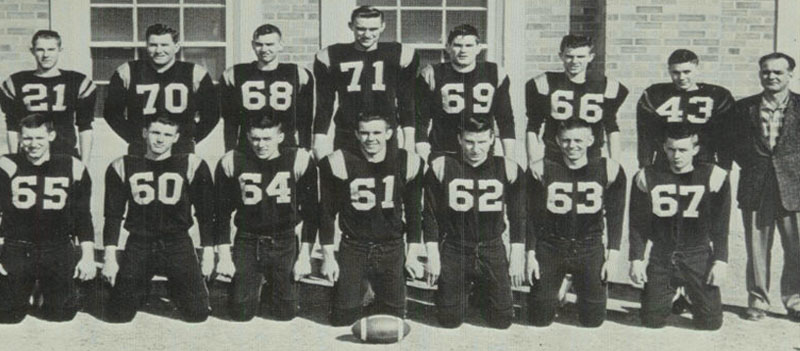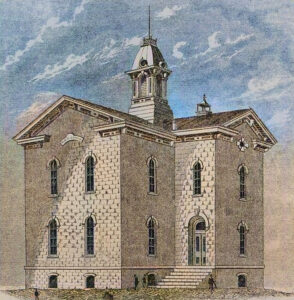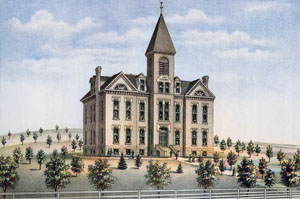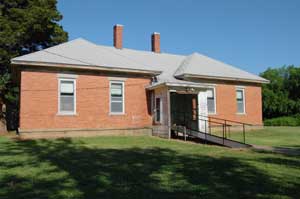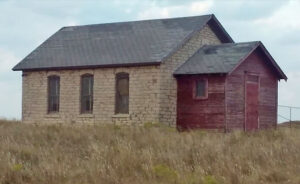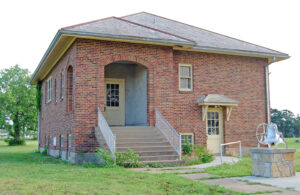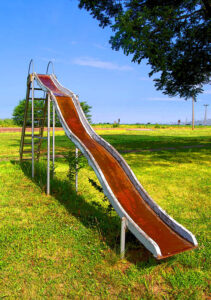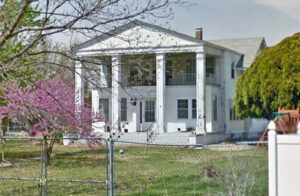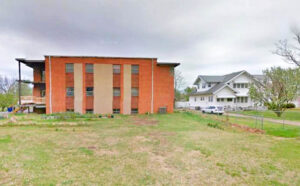Greenwood County, Kansas, was first settled in 1856 but was not organized until 1862. The early educational interests fell into the hands of those determined to make the school facilities keep pace with the rapid increase in the school population. Those endeavors to reach and maintain a high standard of educational work were met with a flattering degree of success.
The first school in the county appears to have been taught near the present city of Madison, in the north part of the county. However, Edwin Tucker taught at a private school in Eureka in the fall of 1858. This was four years before the organization of the county and ten years before Eureka was little more than a country post office.
Among the pioneer teachers were Edwin Tucker, Miss L. L. Tucker, Miss Anna Cutter, H. A. Dales, Miss Mary Claycomb, Arthur Gleason, and L. N. Fanchier. These were taught in the days when logging huts, dugouts, slab shanties, and rock forts were the abodes of the settlers.
As early as 1870, a county normal institute was organized and held in Eureka. Twenty-five teachers were enrolled. The chairman appointed a committee on the program of proceedings, which reported a series of exercises that were adopted. Miss Stamm and Mr. Barrier were appointed critics for the day. Miss Hawkins conducted exercises in reading. Questions for discussion: ‘What is reading?’ Defined by Miss Hawkins, that reading is the adequate expression of the thoughts and emotions of a written or printed composition in vocal utterances,’ which definition was followed by a short lecture on reading, which was listened to by all with great interest. Nearly all who were present participated in a discussion on pronouncing words. It was then moved by Mr. Watt that the institute sessions be held from 9 a.m. to 12 p.m. and from 2 to 5 p.m. Thus, the records proceed to chronicle faithfully each day’s proceedings until we find that, with exercises in reading, spelling, gymnastics, arithmetic, music, grammar, geography, diagraming, addresses, and lectures, we have reported the doings of one of the first normal institutes in Kansas.
In 1867, there were 17 organized districts in the county. Still, after that date, districts were organized with great rapidity, and, in the year 1879, there were 80 districts, with a reported school population of 3,424; in 1882, 90 districts, with a school population of 4,219; and in 1887 there were 106 districts, with a school population of more than 6,000. In 1892, Greenwood County had 113 organized districts and 129 schoolrooms outside Eureka, in which 3,807 students were enrolled. The total school population was 5,601 persons.
In 1866, the amount disbursed for teachers’ wages was over $1,400, and the number of children attending school during that year was over 600.
With increased population, better-tilled farms, and better farmhouses and their resulting comforts came a fresh supply of enthusiasm for education, which gradually tended to systematize the school work throughout the county until it ranked among the first in the state. Much credit was due the tax-payers of the county, upon whom of necessity the chief burden must fall. First-class work was demanded, which could only be secured at the price of first-class wages. The teachers and county superintendents have been diligent and earnest in organizing the work to make it more effective and succeeded in grading all the county’s schools.
To Georgiana Daniels, much credit was given for having prepared the first course of study for the common schools of the county. This course of study was carefully prepared and contained many practical suggestions that aided teachers greatly in their work. This course contained a plan for adoption for each district.
The work of organization and graduation moved steadily forward, and each year marked a step higher in the educational scale of advancement. Using normal institutes, reading circles, and county and district associations, the teachers became broader, deeper, and more thoroughly competent in performing their duties in the schoolroom, with greater satisfaction and better and more permanent results than it was possible to attain in the past. The old and inconvenient school buildings were replaced by large, commodious, and well-ventilated schoolrooms, many of which were fully equipped with the latest and most valuable aids and appliances necessary to further the cause of education.
Eureka was the pioneer town of the county in educational matters. In 1865, some years before it was more than a crossroads post station, Mr. Edwin Tucker started a private school for the convenience of his neighbors. Later, after the county was organized and school-district boards took up the work of providing means for the education of the youth of this and other hamlets, Edwin Tucker, Miss L. L. Tucker, Miss Anna Cutter, Arthur Gleason, L. N. Fanchier, H. A. Dales, Miss Mary Claycomb, and others wielded the birch in Eureka, or, more probably, the hickory.
Early in the 1870s, filled with a belief in the future greatness of Eureka, the people erected a stone schoolhouse on Prospect Hill for $20,000. The significant cost of this building was primarily because teams hauled everything except the stone from Emporia, 50 miles away.
In 1882, Greenwood County had 90 school districts with 2,987 enrolled students taught by 97 teachers. At that time, the value of all school property was $77,000.00, with $42,490.82 in annual expenditures.
The Southern Kansas Academy was organized under the auspices of the Southern Association of Congregational Churches of Kansas. In September 1884, the association voted to locate the academy at Eureka and to endow it liberally, provided a site and suitable building were furnished by those locally interested in such an institution. The citizens of the town and county donated a site of 15 acres and erected a brick and stone building for $13,000. The school was opened in September 1886, with Professor A.J. Burnell as principal.
The academy did ordinary academic work, fitting its graduates to enter the freshman class of the State University or other similar institutions. The purpose of its founders was to establish and maintain a Christian school of a high order but altogether nonsectarian. The enrollment for the year 1892-93 was about 80. The courses of study were Classical, scientific, literary normal, and preparatory. The classical course prepared students for the classical course in college. A thorough foundation was laid. Much time was given to sight reading and care to good English in translation. Classical history, geography, and literature were made familiar. In addition to most academic courses, the school offered a whole year in general history.
The building was a large, light, and well-ventilated structure, two stories above the basement and well-adapted for school purposes. It commands a fine view of the city and the surrounding country. The library contains over 1,000 volumes, well cataloged. The cabinet of rocks and minerals contained about 500 specimens. The academy occupied one of the most favorable locations in southern Kansas, situated on an eminence at the north end of Main Street in Eureka. The population is about 2,500, without a saloon, six churches, and a good waterworks system and electric lights. It was accessible by the Fort Scott, Wichita & Western railway or the Howard branch of the Atchison, Topeka & Santa Fe Railway, connecting Emporia and Moline.
With the advent of railroads came a significant increase in the town’s population and a great diminution in the cost of the building. A second four-room stone building was erected in the western part of Eureka, Kansas, in 1886, and a two-room frame building was built in the northern part for only $10,500. These buildings accommodated nearly 600 students, and all of them were pleasantly located and were surrounded by ample playgrounds. The one on Prospect Hill, with the high bluffs bordering Fall River in the far and near distance, commanded one of the finest views in the county. From 1872 to 1883, aided by three to seven teachers, the educational work in the Eureka schools deepened and broadened.
During the next five years, L.C. Wooster, under the direction of the district board and finally of the board of education, reorganized the schools and established a course of study. This course of study gave an outline for 12 years of work in the common and preparatory branches of study and became the basis for the subsequent excellent work done in the schools. This course was especially strong in language work and the natural sciences. W.S. Picken, who became superintendent in 1888, adapted this course more closely to the requirements of the State University and, by shortening it by one year, prepared a class for graduation in June 1889, the first in the history of the schools.
In 1891, E. T. Hand and 1892, G. A. Bower became superintendents, profiting from the mistakes and successes of their predecessors and guiding the school work into the stiller waters surrounding long or well-established precedents.
In 1892, the total amount received for school purposes was $50,160.01, and the total amount paid out during the year for school purposes was $42,040.99. Of this amount, $31,701.23 was paid for teachers’ wages and supervision.
The needs of a rapidly increasing population were met with greater difficulty. All sorts of buildings needed to be brought into use. At various times, one small building at Eureka served the purpose of a saloon, city hall, engine room, primary school building, and later a stable. But here, as elsewhere, permanent buildings were erected as soon as possible and sometimes sooner than perhaps was wise, and all modern conveniences were given to the school children.
The taxation burden was unequally distributed among the districts of Greenwood County. Those districts so fortunate as to be traversed by one or more railroads could readily employ such teachers as they wished and erected and furnished all the school buildings they needed without being heavily burdened with taxation. District No. 4, in which Eureka was situated, was one of the most favored in the county in this respect, and the railroad taxes were considered one of the most potent factors in the growth of the Eureka schools.
Today, Greenwood County has three school districts.
Eureka USD 389 is a public unified school district headquartered in Eureka, Kansas. The district includes the communities of Eureka, Climax, Toronto, Neal, Piedmont, Reece, Tonovay, and nearby rural areas.
It operates the Eureka Jr/Sr High School and the Marshall Elementary School, both in Eureka.
Hamilton USD 390 is a public unified school district headquartered in Hamilton, Kansas. The district includes the communities of Hamilton, Quincy, and nearby rural areas. The school district operates the Hamilton High School and Hamilton Elementary School.
Madison-Virgil USD 386 is a public unified school district headquartered in Madison, Kansas. The district includes the communities of Madison, Virgil, Lamont, and nearby rural areas. It operates the Madison Junior High School and Madison Elementary School.
Historic Schools of Greenwood County
| Name | District | Years of Operation | Location & Information |
| Climax | 25 | ?? |
The high school in Climax, Kansas, closed in 1957, and its grade school closed in 1969. This image is probably the grade school. |
| Ivanpah | 72 | 1880-19?? |
The Ivanpah school was built in 1880 of limestone and wood frame. The school is about nine miles northwest of Reece on County Road 38. |
| No. 8 | 8 | 1930-1952 |
Number Eight School is one of the few one-room schoolhouses made of brick and still in excellent shape. During the Great Depression, the district spared no expense on the building, and after its completion in 1930, it was known statewide as the most modern one-room school of its day. It features hard-fired dark-red brick outside with two arched entryways, inside boys’ and girls’ restrooms and cloakrooms, running water, a stage, a small library, a full basement, a large activity space, a kitchen, and a huge gravity flow furnace. The first District No. 8 Schoolhouse existed from 1865 to about 1883, below the hill east of the present structure. The second wooden structure was built on the present site and used until 1930. The third and present structure was built during six months in 1930 and was first opened for use on December 3, 1930. It was used continuously until the end of the school year in 1952. In about 1980, the District No. 8 School board members faced school consolidation. They bought back District No. 9 by paying legal costs of around $350.00. This was done to ensure that the building would never be used as a “roadhouse, ” tavern, or anything other than a school. The one-story rectangular brick building with a hip roof was constructed of brick on the outside, with the entrance facing south. The upper story has a classroom with a stage to the west. The building was totally electric, including an electric pump to supply running water. The full basement is divided into a 30′ x 23′ activity space, furnace, storeroom, and kitchen. Number Eight School is located at 2371 KS-58 Highway, about 2.5 miles east of Madison, Kansas.
|
| Utopia College | NA | 1947-1970 |
This building is associated with Utopia College, founded in 1947 by Massachusetts economist and philanthropist Roger Babson. He founded the school out of concern over what he perceived as a coming third world war. He also administered Babson Institute in Massachusetts and Webber College in Florida. He established the college in Eureka because he was highly concerned about an atomic war and determined the country’s middle was safest and would best survive the war. Eureka was at the heart of what he called the Magic Circle, an area that included parts of Iowa, Missouri, Arkansas, Oklahoma, Kansas, and Nebraska. It was later renamed the Midwest Institute of Business. Babson died in 1967, and the school closed in 1970. This property originated as a Craftsman-style home in about 1920 and was updated in the late 1940s to include a tall, two-story front porch. Privately owned today, it is located at 708 E. 5th Street in Eureka, Kansas. |
| Utopia College Building | 1960-1967 |
This building was associated with the Midwest Institute of Business, formerly Utopia College, founded in 1947 by Massachusetts economist and philanthropist Roger Babson. He founded the school out of concern over what he perceived as a coming third world war. Babson died in 1967, and the school closed in 1970. This two-and-a-half-story brick building was designed in the Modern/Modern Movement with a flat roof. It was likely used as a dormitory. Privately owned today, it is located at 522 N. Nicholas Street in Eureka, Kansas. |
Historic School Districts of Greenwood County
| School Name | Location | District Name | District # | School Name | Location | District Name | District # | |
| Madison | 1 | Toronto | 56 | |||||
| Virgil | 2 | Fall River. | 57 | |||||
| Virgil | 5 | Reece. | 58 | |||||
| Toronto | 6 | Hamilton | 59 | |||||
| Quincy | 7 | Reece | 60 | |||||
| Madison | 8 | Eureka | 62 | |||||
| Neal | 9 | Eureka | 63 | |||||
| Eureka | 10 | Eureka | 64 | |||||
| Eureka | 11 | Lapland | 65 | |||||
| Twin Falls | 12 | Twin Falls | 66 | |||||
| Twin Falls | 13 | Utopia | 67 | |||||
| Madison | 14 | Virgil | 68 | |||||
| Neal | 15 | Hill Top | 69 | |||||
| Willow Valley | 16 | Eureka | 70 | |||||
| Quincy | 17 | Piedmont | 71 | |||||
| Toronto | 18 | Ivanpah | 72 | |||||
| Utopia | 19 | Madison | 72 | |||||
| New Alban | 20 | Severy | 74 | |||||
| Lapland | 21 | Neal | 75 | |||||
| Eureka | 22 | Lapland | 76 | |||||
| Star | It was northwest of Piedmont. | Eureka | 23 | Madison | 77 | |||
| Hamilton | 24 | Madison | 78 | |||||
| Climax | 25 | Madison | 79 | |||||
| Fall River | 26 | Hamilton | 80 | |||||
| Piedmont | 27 | Climax | 81 | |||||
| Piedmont | 28 | Severy | 82 | |||||
| Eureka | 29 | Beaumont | 83 | |||||
| Quincy | 30 | Fall River. | 84 | |||||
| Fall River | 31 | Madison | 85 | |||||
| Climax | 32 | Eureka | 86 | |||||
| Eureka | 33 | Fall River | 87 | |||||
| Fall River | 34 | Phurman | 88 | |||||
| Toronto | 35 | Hamilton | 89 | |||||
| Greenwood | 36 | Eureka | 90 | |||||
| Climax | 37 | Eureka | 91 | |||||
| Neal | 38 | Piedmont | 92 | |||||
| Severy | 39 | Seeley | It was southwest of Madison | Madison | 94 | |||
| Severy. | 41 | Beaumont | 95 | |||||
| Eureka | 42 | Hamilton | 96 | |||||
| Hamilton | 43 | Virgil | 97 | |||||
| Fall River | 44 | Severy | 98 | |||||
| Fall River | 45 | Madison | 99 | |||||
| Madison | 46 | Madison | 100 | |||||
| Fall River | 47 | Hamilton | 101 | |||||
| Reece | 48 | Prairie Belle | It was southeast of Madison | Madison | 102 | |||
| Eureka | 49 | Gaffney, Four Corners | It was in Janesville Township, west of Hamilton. | Hamilton | 103 | |||
| Eureka | 50 | Barrey | Jt Dist. #2 | |||||
| Eureka | 51 | Madison | Jt Dist. #40 | |||||
| Eureka | 52 | Matfield Green | Jt Dist. #93 | |||||
| Lena Valley | 53 | |||||||
| Piedmont | 54 | |||||||
| Severy | 55 |
©Kathy Alexander/Legends of Kansas, January 2024.
Also See:
One-Room, Country, & Historic Schools of Kansas
Sources:
Cutler, William G; History of Kansas; A. T. Andreas, Chicago, IL, 1883.
Historic Public Schools of Kansas
Kansas Historic Resources Inventory
Kansas State Historical Society, The Columbian History of Education in Kansas, Hamilton Printing Company, Topeka, KS, 1893.
RootsWeb

